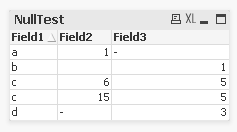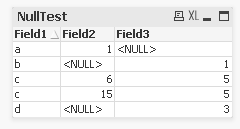Unlock a world of possibilities! Login now and discover the exclusive benefits awaiting you.
- Qlik Community
- :
- All Forums
- :
- QlikView App Dev
- :
- Replace NULL and missing values as part of ETL for...
- Subscribe to RSS Feed
- Mark Topic as New
- Mark Topic as Read
- Float this Topic for Current User
- Bookmark
- Subscribe
- Mute
- Printer Friendly Page
- Mark as New
- Bookmark
- Subscribe
- Mute
- Subscribe to RSS Feed
- Permalink
- Report Inappropriate Content
Replace NULL and missing values as part of ETL for data quality?
Sorry for any inconvience with posts, there were a lot of errors when trying to publish this one and you answered faster than I could repair that ![]()
Dear all,
Suppose within the ETL process, I extract a table as following:

The NULL resulted from a JOIN, the missing value in Field2 of row "b" is just empty.
My question is: As part of ETL, are the following steps any good or do they even produce more harm later?
Step 1: Replace all NULLs with <NULL>; to make them selectable in Listboxes:
// Treat all NULL fields as a value
NullAsValue *;
// Set the value to replace NULL. In optimized QVD-loads add the condition where 1=1 or it will not work.
Set NullValue = '<NULL>';
New Table:

Step 2: Replace also the missing value with <NULL>:
Set NullInterpret = ''; // This will convert all blank fields to NULL in Excel files
New Table:

These steps in my opinion enable advanced analyses, but I am not sure whether to implement it everywhere. Going further: Do you think it makes sense to fill all NULL or missing values in all tables already when they are extracted from the source systems?
Nachricht geändert durch Georg Gottsmann
Accepted Solutions
- Mark as New
- Bookmark
- Subscribe
- Mute
- Subscribe to RSS Feed
- Permalink
- Report Inappropriate Content
I think you are right that there could be no clear recommendation to replace NULL in a single field and/or all fields - it will be always depend on the particular requirements of an application if it's useful or not.
In my experience it's often useful to replace NULL within fields which are used as dimensions but not in fields which are measured within the expressions (whereby you could of course react on any replacing-value within the expressions).
- Marcus
- Mark as New
- Bookmark
- Subscribe
- Mute
- Subscribe to RSS Feed
- Permalink
- Report Inappropriate Content
What is your question? I mean what exactly your requirement is !
- Mark as New
- Bookmark
- Subscribe
- Mute
- Subscribe to RSS Feed
- Permalink
- Report Inappropriate Content
Please try to avoid posting multiple times the same request.
This makes it hard to follow a discussion.
If you want to replace the NULL after a JOIN, you would need to perform a subsequent RESIDENT LOAD in which you check for NULL and replace it with something meaningful:
LOAD
if(Len(Trim(FIELD)), FIELD, 'Formerly known as NULL or empty') as FIELD
RESIDENT YourTable;
Or don't JOIN, use ApplyMap() instead:
- Mark as New
- Bookmark
- Subscribe
- Mute
- Subscribe to RSS Feed
- Permalink
- Report Inappropriate Content
I think he is asking if it's a good practice to replace NULL values with a "selectable" <NULL> String, but he is unsure if that will have any impact later in his application.
My opinion is that it all comes down to your own particular requirements. Do selectable nulls make sense o not in the context of your application?
Cheers
- Mark as New
- Bookmark
- Subscribe
- Mute
- Subscribe to RSS Feed
- Permalink
- Report Inappropriate Content
There are different types of NULL which also needs different methods to be handled. A very good explanation could you find here: NULL handling in QlikView.
- Marcus
- Mark as New
- Bookmark
- Subscribe
- Mute
- Subscribe to RSS Feed
- Permalink
- Report Inappropriate Content
That's a very good explanation. Thanks for the heads-up Marcus.
Cheers
- Mark as New
- Bookmark
- Subscribe
- Mute
- Subscribe to RSS Feed
- Permalink
- Report Inappropriate Content
Thank you, that's right. My question was:
"Does it generally make sense to replace all NULLs with a placeholder, say "unknown", "w/o" or "<NULL>" etc.?
I read all I could find in the community, be it "NULL and Nothing" from HIC orothers. I think that it might lead to following issues:
1) Aggregations like avg() will lead to wrong results because e.g ."0" instad of "NULL" is counted as a valid denominator.
2) When doing JOINS, rows might get duplicated, again distorting mathematical operations
3) Sometimes there are reasons for NULL which is not the same as a "missing value". In that case, interpretations may be effected as well.
So all in all, it really depends on the particular case and you have to ask questions like "What does this NULL mean?", "Why is it there"? and "Does it make sense to replace it e.g. with <NULL> as a workaround or is this the result of bad data quality in the source systems".
Please correct me or add something, but I think that is everything general one can say about it.
- Mark as New
- Bookmark
- Subscribe
- Mute
- Subscribe to RSS Feed
- Permalink
- Report Inappropriate Content
I think you are right that there could be no clear recommendation to replace NULL in a single field and/or all fields - it will be always depend on the particular requirements of an application if it's useful or not.
In my experience it's often useful to replace NULL within fields which are used as dimensions but not in fields which are measured within the expressions (whereby you could of course react on any replacing-value within the expressions).
- Marcus